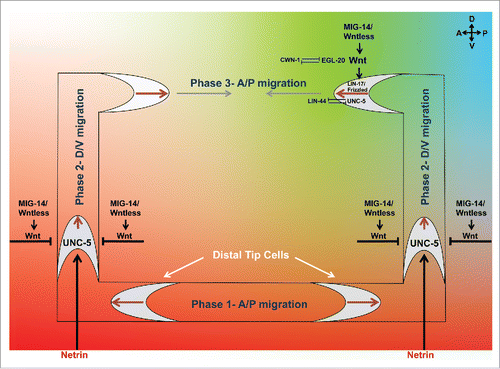Figures & data
Figure 1. The C. elegans hermaphrodites U-shaped gonad arms are formed by 3 sequential migration phases of the anterior and posterior DTCs (marked as white crescent shaped cells), both undergoing a mirror image symmetrical pattern of migration. The DTCs are born in the mid-body, their first migration phase (phase 1) occurs along the A/P axis in opposite directions; the anterior DTC migrates toward the head while the posterior DTC migrates toward the tail. At the onset of the second migration phase (phase 2), the DTCs pause and reorient to polarize along the D/V axis. This phase 2 D/V migration is dependent on the unc-5 Netrin receptor, which is transcriptionally up-regulated at the time of the turn.Citation26 The polarity information determining the directionality along the D/V axis is provided by the UNC-6/Netrin guidance cue,Citation15,26 which is secreted from ventral sourcesCitation16 (depicted by the red gradient). UNC-5 also functions redundantly with Wnt signaling components to regulate D/V guidance.Citation23 Wnts are distributed along the A/P axis. Some Wnts (like EGL-20) are secreted from posterior sources, while others (like CWN-1 and CWN-2) are secreted from more anterior sources. Gradients of CWN-1/Wnt (green) and EGL-20/Wnt (blue) are depicted based on published expression studiesCitation25,36 mig-14/Wntless is necessary to facilitate Wnt secretion and was found to have substantial impact on egl-20/Wnt gradients.Citation29,50 The last migration phase of the DTCs (phase 3) occurs once again on the A/P axis where the DTCs migrate back toward the mid-body. The polarity and consequently the direction of the migration throughout this migration phase is determined by a fine balance between different Wnts (such as cwn-1 and egl-20) or Wnts (such as lin-44) and unc-5.Citation23 Dorsal is up and anterior is left. Red arrows mark the direction of DTC movement. Black arrows represent genetic interactions (positive or negative). Gray arrows represent the route yet to be taken by the DTCs, which stop migrating as they reach the mid-body.

